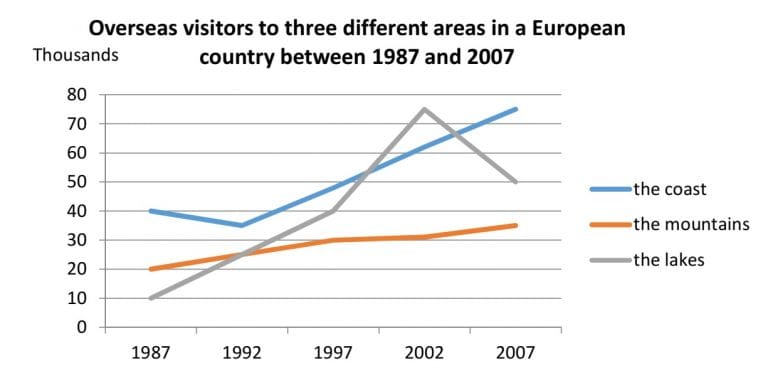[Amier F] Writing Practice Test 1390350
Task 1
You should spend about 20 minutes on this task.
The graph below shows the number of overseas visitors to three different areas in a European country between 1987 and 2007
Summarise the information by selecting and reporting the main features, and make comparisons where relevant.
You should write at least 150 words.

The graph illustrates the number of overseas visitors to three different areas which are the coast, the mountains and the lakes in a European country between 1987 and 2007. In general, there were a significant difference of the number of overseas visitors between this three different areas.
According to the graph, the coast become the most favourite overseas visitors around 40 thousands at the 1987 and hava a significant dropped around 10 thousands at 1982. Then, the graph rose gradually to around 75 thousands at 2007. In contrast, overseas visitors at the mountains are increased dramatically from 20 thousands at 1987 to 30 thousands at 1997 and it levelled of until 2002. The amount of overseas visitors at the mountains are increased to around 35 thousands at 2007. Lastly, the overseas visitors at the lake were increased substantially from 10 thousands at 1987 to 40 thousand at 1992. Then, it increased sharply around 35 thousands and dropped to 50 thousands at 2007.
In conclusion, the amount of overseas visitors at the mountains and the coast are increased while the lakes are dropped.
Task 2
You should spend about 40 minutes on this task.
Some countries achieve international sports by building specialised facilities to train top athletes, instead of providing sports facilities that everyone can use. Do you think this is positive or negative development?
Discuss both views and give your opinion.
You should write at least 250 words.
Do you know the differences between the specialised facilities and sports facilities? The specialised facilities are the place for an athlete in term of health care and improvement for the athlethes meanwhile sports facilities is the items or a material for sports such as ball for football and volleyball which are mostly for everyone to use. There are a positive development by building facilities to train top athletes, instead of provide sports facilities that everyone can use which are increase efficiency and the negative side which is limited access for the general public.
The first positive development by building facilities to train top athletes is increase efficiency. The athletes can training based on the instructions and their requirement they need. For example, if they want to developed more skills in football, they must do the activities that require the physical contact such as squat and doing a football drills. This will make the athletes become more focus with what they do which make them become more proactive with their activities. In addition, it can focus more to a pro-athletes than a normal athletes which they can develop them to become a success athelets than other.
Otherwise, some of negative development by building specialised facilities which is it become limited access for general public because there are very a tiny amount of sports facilities that they can use. The normal people have a less option which will lead them to uninterest in the sports anymore. So, the coach can not find a substitute for the older athletes. If this continue, the country can not produce a talented athletes who will become a pride for a certain country.
In conclusion, increasing efficiency is the positive development by building specialised facilities such as and limiting access for the general public is the negative development by building specia;ised facilities to train top athletes, instead of providing sports facilities that everyone can use. By balancing between specialised facilities and sports facilities can improve the sports managemant in the certain country.
Community’s feedback
Sorry! We couldn't find any contents.
Score Given by Community
Give a bandscoreLeaderboard:
| # | User | Score | Time | |
|---|---|---|---|---|
| Yuki Arai |  | 7.0 | 00:35 | |
| Rie Kimoto |  | 6.0 | 52:48 | |
| Salina Tang |  | 6.0 | 57:08 | |
| 4 | Refan Alsuhaibani |  | 5.5 | 59:59 |



